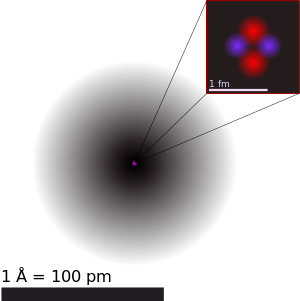Helium-4
However, numerical approximations of the equations of quantum mechanics have given a good estimate of the key atomic properties of helium-4, such as its size and ionization energy.
Adding another of any of these particles would require angular momentum, and would release substantially less energy (in fact, no nucleus with five nucleons is stable).
This arrangement is thus energetically extremely stable for all these particles, and this stability accounts for many crucial facts regarding helium in nature.
Some stable helium-3 is produced in fusion reactions from hydrogen, but it is a very small fraction, compared with the highly energetically favorable production of helium-4.
The stability of helium-4 is the reason that hydrogen is converted to helium-4, and not deuterium (hydrogen-2) or helium-3 or other heavier elements during fusion reactions in the Sun.
The binding of the nucleons in helium-4 is so tight that its production consumed nearly all the free neutrons in a few minutes, before they could beta decay, and left very few to form heavier atoms (especially lithium, beryllium, and boron).
It is barely energetically favorable for helium to fuse into the next element with a higher energy per nucleon (carbon).

